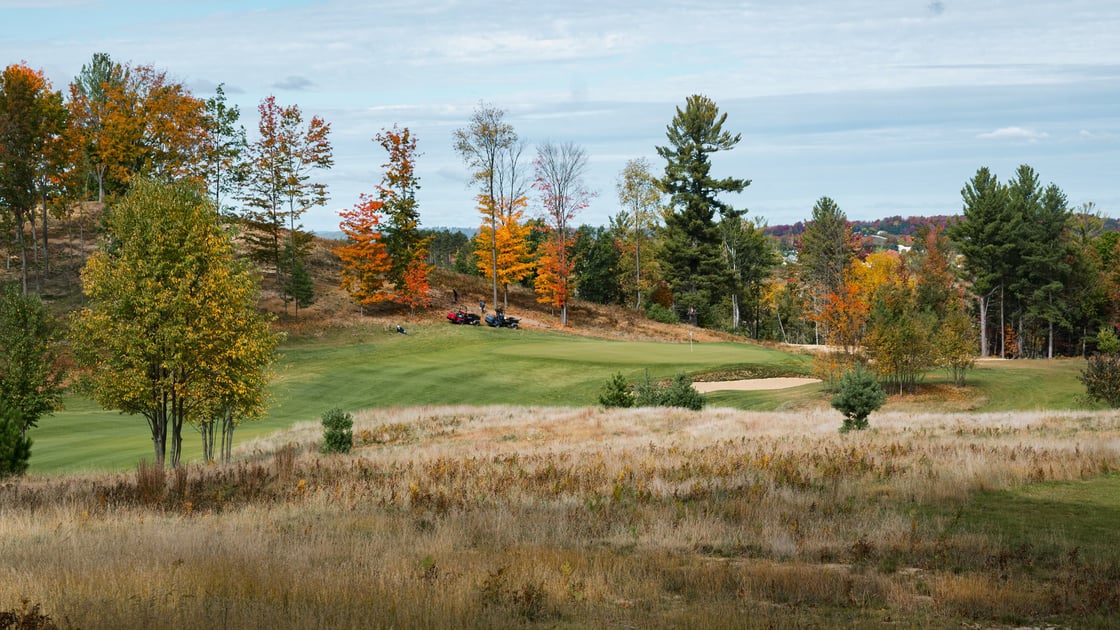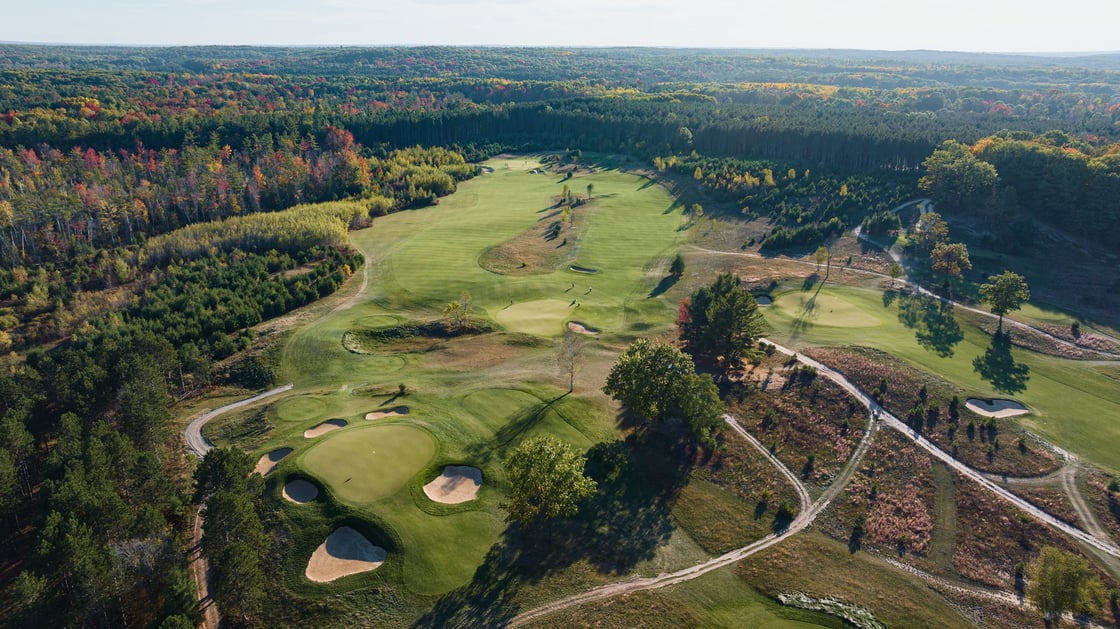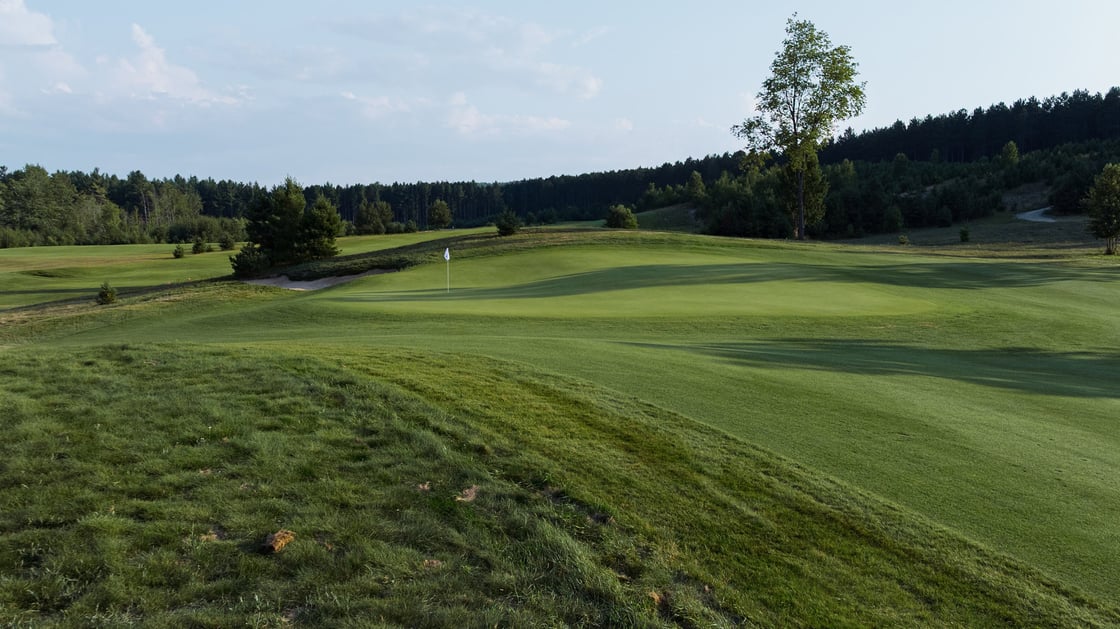The Original Tom Doak Course, Lost Then Reborn
On a serendipitous return to High Pointe


There’s a risk in returning to a place you once held so fondly. Nostalgia tends to forget certain details or embellish others. You have changed. The place has changed. But when you find yourself at the threshold of a genuine reunion, a feeling of timeless familiarity resonates. The long tether linking your present and your past becomes so tightly coiled that the two become almost indistinguishable.
The first 18-hole round of golf I played as a child was at Tom Doak’s High Pointe Golf Club. A coincidence that went unnoticed by my eight-year-old self, and one that I did not come to appreciate until a decade ago. Fried Egg Golf’s early “Yolk with Doak” podcasts played a part in reviving my interest in golf. The concepts of golf course architecture Andy and Doak discussed offered a way of describing a course that no longer had to be in relation to my own shotmaking. I could instead encounter courses as artistic landscapes, intentionally laid out fields of play, and begin to consider the many decisions and constraints that went into shaping features, hazards, and greens. This early education led me to collect Doak’s volumes of The Confidential Guide to Golf Courses and The Anatomy of a Golf Course, where Doak lists High Pointe in his “Golf Courses Worthy of Study” appendix, and where the realization dawned on me that my first round occurred on his first original design.
This study became impossible after High Pointe shut down amidst the financial crisis of 2008. Most of its acreage was redeveloped into a commercial hops farm. My newfound appreciation for the course felt ill-timed when I drove past it in 2018, as row after row of green trellised ribbons flickered past my car window. But, under the guidance of new owner Rod Trump and his founding membership, High Pointe was brought back in 2024 as a reimagined private national club.
{{inline-course}}
On an August morning this summer, almost thirty years since I last played it, I returned to High Pointe. The sunrise over Grand Traverse Bay was rusted over by wildfire smoke from Canada, settling into an overcast haze by the time I arrived. I was delighted to find that the temporary clubhouse during construction was remodeled within the course’s original clubhouse. The cracks in the old parking lot ushered in a moment of circularity for when I first parked there with my father as a boy.
I was eager to see the cohesiveness of Doak’s new and restored holes given the chasm of time and experience separating them. If standing in the parking lot seemed strange for me, imagine how uncanny it must have been for Doak. He first surveyed this land as a 26-year-old without a design credit of his own, and returned with many of the world's highest regarded modern designs now associated with his name.
Much of Doak’s routing is laid out on a parcel away from his 1989 design. It reconnects with six original holes that many considered among its best stretches, restored as the new course’s eighth (old 10th), ninth (old 11th), 12th, 13th, 14th, and 15th holes. The redesign stands alone in Doak’s portfolio; no other course of his weaves together holes that span from the first green he ever built himself (the 13th) to those built in what is now the later stage of his prodigious career.

What I found is a mature design with a quiet confidence in its features. The course’s sandy, undulating terrain is grand without being overly severe, fitting for the club’s walking-only ethos. With few exceptions, Doak’s design treads lightly, harkening back to the lay of the land aesthetic that gained High Pointe popularity in the early 1990s, when its minimalism was a countercultural shock.

The course gathers you in its poised composition. One green might prioritize the prevailing angle of a natural slope, like the first, 12th, or 13th. Others allow for internal contours to flourish, like the second, 11th, and 16th. Fairway and greenside bunkers utilize simple oblong shaping, with only one ornate hazard on the 12th punctuating an elegant exception to the rule.
A familiarity transcends High Pointe’s new holes because Doak preserved what made his first course seminal. After all of these years, he still honors the land’s particularities. Its inked fingerprint on a topographic map informs his process of locating greensites and piecing together their corridors. A testament to how Doak’s fundamental approach hasn’t changed is how nine of these “new” holes appear on Doak’s initial 1987 routing, when he sketched out a potential 27-hole facility. That speculative third nine was routed over land that was never acquired, until Trump did so in 2022. The more time Doak spent revisiting the parcel, the more he knew he could not improve on his old, almost forgotten routing.
A new hole that struck me was the par-4 fifth. A semi-blind tee shot plays over a ridge to a plateau fairway, leaving a shorter approach into a large, contoured green. The putting surface is crowned by a few feet, conjuring the knee-height rolls at the Old Course at St. Andrews or Pinehurst No. 2, where recoveries from firm surrounds can be played from putter to 3-wood.
I also admired the new 11th hole for similar reasons. Its gentle dogleg right employs a single fairway bunker to conceal the drive’s landing area, with an approach played to a rambunctious, tiered putting surface.

Of the restored holes, the dogleg eighth remains a standout par 4, with a tee shot that tumbles to a small, hidden valley, before climbing up a hillside pocked with bunkers and draped in long, tawny fescue to a punchbowl green.
It’s followed by the exacting mid-length par-3 ninth, played to the course’s most heavily guarded green, an elevated tabletop with an infinity edge along its rear surface.
From the ninth green’s perch, I took in a clear view of most of the property’s restored holes. The 12th fairway’s rise to its green, sloping along the hillside. The brief walking trail through the woods to the 13th tee. The crest and fall of No. 13 down to its majestic, saddle-shaped green, before the 14th climbs over the opposite ridge.

The tenets Doak gleaned from his academics in landscape architecture, his readings of golf’s earliest authors, and his extensive studies of links courses throughout Great Britain and Ireland as a student, remain on full display from these earliest holes: A trust that the land’s inherent characteristics can yield golf’s unique features. After all of Doak’s subsequent accomplishments, these holes continue to comprise a beautiful and thrilling stretch of golf. They are the genius loci of High Pointe, Doak’s earliest signature of greatness, whose significance extends beyond the course. They allow golfers to experience, once again, the originating holes of a career whose legacy deserves to endure.
I no longer view my childhood round at High Pointe as a coincidence, but as serendipity. It was purely accidental, yet it became an originating source of my own; a passion for golf informed more by what a course impresses upon me than whatever I might exert on it.
Nearly all of my life fits between the intervals of my last two rounds there. I’m older now than my father was when he first brought me. Across town on Lake Michigan, my two children were playing on the beach with their mother, grandparents, and cousins. My oldest is five, just beginning to join me at the driving range and practice green. I’ve watched his face alight after a struck ball, induced by the fleeting yet delirious sensation that our best shots somehow always seem the most effortless. We belong to a different Doak-designed club, and it’ll be the place where he and my daughter, if they want, will get to play their first 18 holes. A coincidence that I’m sure will go unnoticed by them, but one that will mean so much to me.
High Pointe is undeniably different from the course it once was, just as you and I are from when we were once young, and how Doak is from when he was first starting his career. Yet it remains unmistakably itself, immediately recognizable, like a dear friend you see after far too long an absence. Playing it again made me realize that no matter how much I have changed, the man standing on the 13th green and the boy who once stood at that very spot remain the same. Still enjoying how a golf course can be as endlessly varied as its natural surrounds. Still encouraged by a sport that remains ever-new at each address of a ball. Still believing his best golf is yet to come.

Leave a comment or start a discussion
Engage in our content with thousands of other Fried Egg Golf Club Members
Engage in our content with thousands of other Fried Egg Golf Members
Get full access to exclusive benefits from Fried Egg Golf
- Member-only content
- Community discussions forums
- Member-only experiences and early access to events











Leave a comment or start a discussion
Lorem ipsum dolor sit amet, consectetur adipiscing elit. Suspendisse varius enim in eros elementum tristique. Duis cursus, mi quis viverra ornare, eros dolor interdum nulla, ut commodo diam libero vitae erat. Aenean faucibus nibh et justo cursus id rutrum lorem imperdiet. Nunc ut sem vitae risus tristique posuere. uis cursus, mi quis viverra ornare, eros dolor interdum nulla, ut commodo diam libero vitae erat. Aenean faucibus nibh et justo cursus id rutrum lorem imperdiet. Nunc ut sem vitae risus tristique posuere.